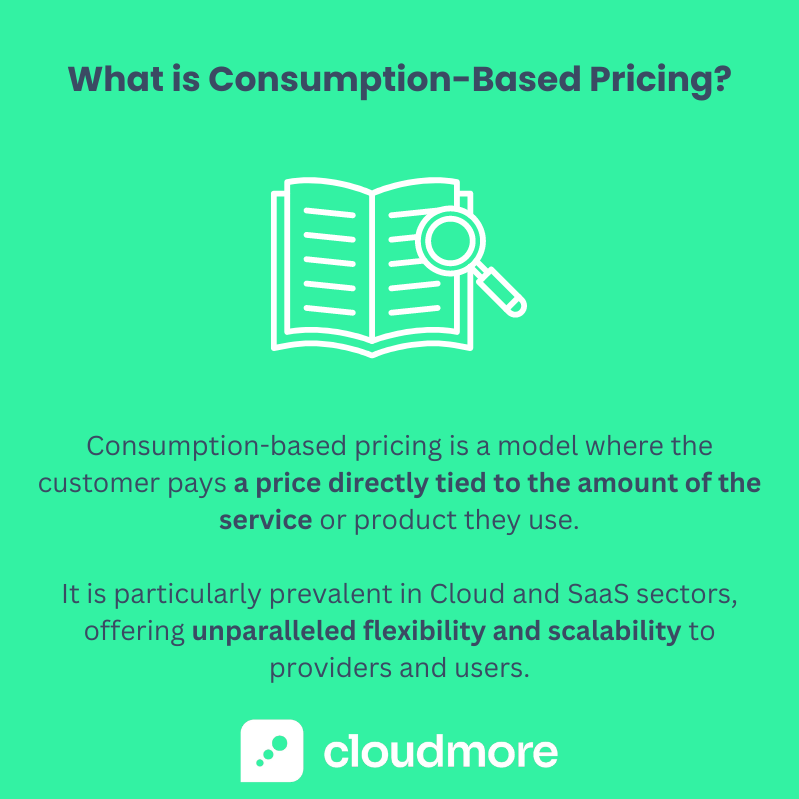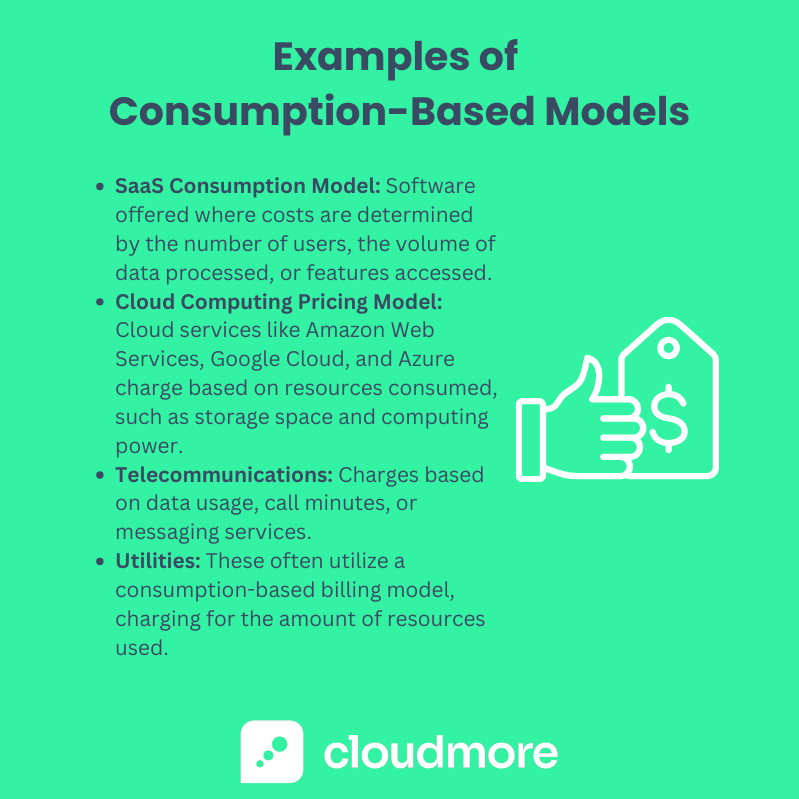What is Consumption-Based Pricing? + Examples of Usage Based Models
Embracing consumption-based pricing is like unlocking a new level of alignment between your services and your customers' evolving needs.
This innovative approach, where usage dictates the cost, transforms industries from cloud computing to SaaS, offering unparalleled transparency and flexibility.
Dive into the heart of what makes consumption-based pricing not just a trend but a strategic necessity in our modern market.
You'll uncover its mechanics, advantages, and real-world applications, providing the insights to decide if this model suits your business.
Understanding Consumption-Based Pricing
Consumption-based pricing is a flexible and innovative billing strategy in today's market.
It aligns costs directly with usage levels, offering a transparent and adaptable approach for businesses and consumers alike.
What is Consumption-Based Pricing?
Consumption-based pricing, also known as usage-based pricing, is a model where the price a customer pays is directly tied to the amount of the service or product they use.

Unlike traditional pricing models, which often involve flat-rate monthly fees regardless of usage, consumption-based pricing ensures you only pay for what you need and use.
This model is particularly prevalent in the cloud services and SaaS (Software as a Service) sectors, offering unparalleled flexibility and scalability to providers and users.
By adopting this model, businesses can offer more personalized pricing packages catering to various consumer needs and consumption patterns.
Benefits of Consumption-Based Pricing
The advantages of consumption-based pricing are twofold, benefiting both businesses and their customers.
This model facilitates a deeper understanding of customer usage patterns for businesses, enabling more accurate forecasting and resource allocation. It also encourages customer loyalty, as users appreciate the fairness and flexibility of paying only for what they consume.
Consumers, on the other hand, gain from increased transparency and control over their expenses. This pricing model allows them to adjust their usage according to their needs and budget, avoiding the pitfalls of overpaying for unused services. Moreover, it opens the door to a broader range of services and products, as even those with variable usage rates become more accessible.
By marrying financial flexibility with strategic insights, consumption-based pricing enhances customer satisfaction and drives innovative business growth.
Consumption-Based Pricing in Action
As consumption-based pricing gains traction across various industries, understanding its application and impact becomes crucial for businesses and consumers.
This approach revolutionizes how companies bill their customers and how value is perceived and optimized on both ends.
How It Works: The Mechanics of Consumption-Based Models
At its core, the consumption-based pricing model is straightforward: charges are based on the extent of service or product usage.
Operationally, this entails meticulous tracking and reporting of usage metrics, ranging from data stored, data transferred, number of transactions processed, or the hours of service used.
This data is then applied against a pricing structure that scales with consumption levels, ensuring that billing is accurate and reflects actual use.
For businesses, this model requires robust systems for tracking usage data and transparent and communicative billing processes to ensure customers understand their usage and associated costs. It's a model that champions adaptability and precision, offering a billing solution that grows and adjusts to the needs of both the provider and the consumer.
Examples of Usage-Based Models
Consumption-based pricing models have found a foothold in many industries, illustrating their versatility and consumer appeal. Some prominent examples include:
- SaaS Consumption Model: Software providers offer plans where costs are determined by the number of users, the volume of data processed, or features accessed.
- Cloud Computing Pricing Model: Cloud services like Amazon Web Services (AWS), Google Cloud, and Azure consumption-based model charge based on resources consumed, such as storage space and computing power.
- Telecommunications: Charges based on data usage, call minutes, or messaging services.
- Utilities: Electric, gas, and water services often utilize a consumption-based billing model, charging households and businesses for the resources used.
Through these examples, it's clear that consumption-based pricing models offer a flexible, fair, and transparent way to cater to a diverse customer base, ensuring that users pay in proportion to the value they receive.

This approach enhances customer satisfaction, encourages responsible consumption, and helps businesses tailor their offerings more closely to customer needs.
Key Industries and Players
Consumption-based pricing is revolutionizing how businesses across industries approach billing and customer engagement.
This model's flexibility and fairness are particularly appealing in sectors where usage can significantly vary.
SaaS and Cloud Services: Leading the Way
In Software as a Service (SaaS) and cloud computing, consumption-based pricing has become a cornerstone of business strategy.
Companies like Microsoft Azure and Amazon Web Services have led the charge, offering services where clients pay solely based on their consumption levels.
This model provides the dual benefits of scalability and cost-efficiency, allowing businesses to adjust resources based on demand without the burden of significant upfront costs.
This flexibility is invaluable for startups and enterprises, enabling rapid scaling that aligns with growth and customer demand.
Beyond Tech: Other Sectors Embracing Consumption-Based Models
While SaaS and cloud services are at the forefront, consumption-based pricing is making significant inroads in other sectors as well:
- Utilities: Electric, water, and gas services have long used consumption-based billing but are now leveraging innovative technology to offer more detailed usage data and pricing tiers.
- Telecommunications: Data and VOIP services offer plans where customers pay based on their data usage or call minutes, allowing for more personalized service packages.
- Transportation: Ridesharing and car rental services offer pay-per-use models, charging based on the distance traveled or time used, providing flexibility for occasional or budget-conscious users.
These examples demonstrate the broad applicability and appeal of consumption-based pricing, showing its potential to transform traditional billing models and enhance customer satisfaction across diverse markets.
Implementing Consumption-Based Pricing in Your Business
Transitioning to a consumption-based pricing model is a strategic move that can significantly enhance your business's flexibility and customer alignment.
This approach requires thoughtful planning and execution to navigate the shift successfully.
Steps to Transition to a Consumption-Based Model
Implementing a consumption-based pricing strategy involves several key steps:
- Evaluate Product or Service Suitability: Assess whether your offerings are compatible with consumption-based pricing. Ideal candidates are easily divisible and have measurable usage metrics.
- Understand Your Customers' Needs: Analyze customer usage patterns and preferences to design a pricing model that offers value and transparency.
- Develop a Pricing Structure: Create a tiered pricing strategy based on usage levels that accommodate different customer segments.
- Upgrade Technology Systems: Ensure your billing systems can accurately track usage metrics and automate billing processes.
- Communicate Changes to Customers: Clearly explain the benefits and changes of the new pricing model to existing and potential customers.
- Monitor and Adjust: Regularly review the model's performance and customer feedback, making adjustments as necessary to align with market demands and operational costs.
Challenges and Considerations
While consumption-based pricing offers many advantages, businesses may encounter several challenges during implementation:
- Complexity in Billing: Transitioning from a flat rate to a usage-based model can complicate billing processes. Invest in robust billing systems to manage this complexity
- Customer Adoption: Some customers may be wary of changing pricing models. Transparent communication about the benefits and cost savings can help alleviate concerns.
- Revenue Predictability: Shifting to usage-based billing can make revenue forecasting more challenging. Establishing minimum usage thresholds or base fees can help mitigate this issue.
- Pricing Sensitivity: Finding the right balance in pricing tiers to remain competitive yet profitable requires careful market analysis and ongoing adjustment.
Adopting a consumption-based pricing model is a strategic decision that can drive growth and customer loyalty. By carefully planning the transition and addressing potential challenges head-on, businesses can leverage this flexible pricing model to meet their customers' needs better and adapt to market dynamics.
Key Takeaways about Consumption-Based Pricing
Consumption-based pricing represents a paradigm shift in how businesses approach billing and customer service. This model, emphasizing flexibility, transparency, and scalability, aligns closely with contemporary consumer expectations and business needs.
Key points to remember include:
- Flexibility and Scalability: Consumption-based pricing allows businesses and consumers to adjust usage and costs according to their needs, promoting scalability and efficiency.
- Customer Centricity: By paying only for what they use, customers feel a greater sense of fairness and control over their expenditures, enhancing satisfaction and loyalty.
- Adaptability Across Industries: While prevalent in SaaS and cloud computing, this pricing model expands into other sectors, proving its versatility and broad appeal.
- Strategic Implementation: Transitioning to a consumption-based model requires careful planning, customer communication, and adjustments based on feedback and market dynamics.
- Navigating Challenges: Recognize and prepare for billing complexity and revenue predictability, leveraging technology and transparent communication to mitigate potential issues.
As businesses evolve in a rapidly changing market landscape, consumption-based pricing offers a compelling alternative to traditional pricing models.
It caters to the growing demand for transparency and flexibility and equips businesses to better respond to customer needs and market fluctuations.
Share this
You May Also Like
These Related Stories

Guide to Usage-Based vs. Subscription-Based Pricing in B2B Models

The Transformational Nature of Usage-Based or Consumption Pricing


